South Africa Itinerary: Complete Road Trip in 2 Weeks (+Map & Tips)
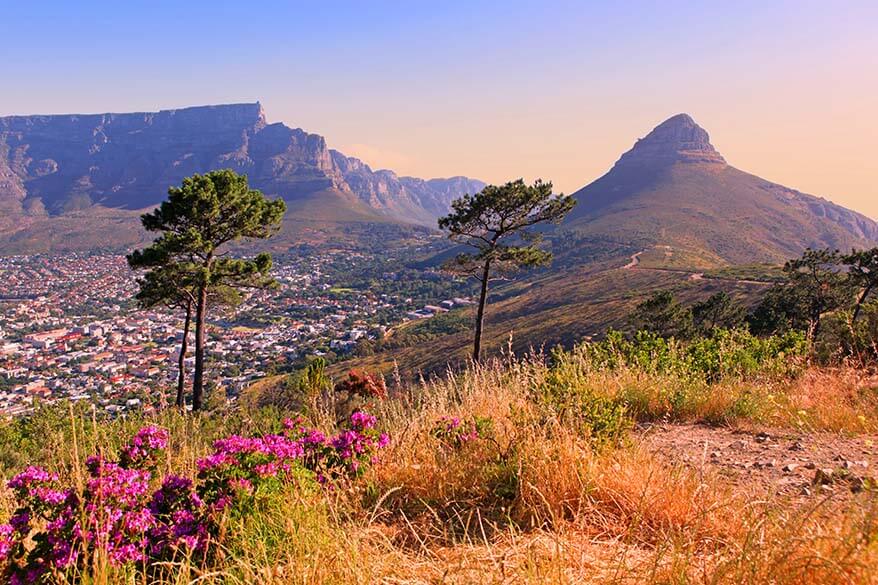
This site contains affiliate links, which means that we may earn a small commission, at no cost to you, for qualifying purchases. It supports the work that goes into keeping this content free. Thanks for reading! More info: Privacy Policy.
On our first evening of a 2-week road trip in South Africa a hippo walked into the garden of our hotel and quietly grazed by the river as we were having dinner just a few steps away. It was at this moment that we fell in love with Africa. The next day we stood at the Three Rondavels viewpoint of the Panorama Route and my husband said ‘just when I thought we had seen it all, South Africa proved me wrong…‘.
South Africa captured our hearts forever and years later it was the first far destination that we visited with our kids, followed by a trip to nearby Namibia and hopefully many more trips to Africa in the future. But it all started with this first trip and so today I want to share our 2-week itinerary for the best of South Africa.
When we first visited South Africa, we only had 15 days to see the best of the country. It’s a big country and, of course, you cannot see everything in just two weeks. But if you are visiting South Africa for the first time and want to see the very best this beautiful country has to offer, then look no further.
This itinerary covers all the main highlights of South Africa, including Kruger Park safari, and shows you the amazing diversity of the Rainbow Nation.
For your convenience, I made a map with our South Africa trip itinerary and also included driving distances/times as well as some tips to help you plan your trip to South Africa. At the bottom of this post, you can also find some practical information for your self-drive trip.
How to use this map: Use your computer mouse (or fingers) to zoom in or out. Click on the icons to get more information about each place. Click the arrow on the top left corner for the index. Click the star next to the map’s title to add it to your Google Maps account. To view the saved map on your smartphone or PC, open Google Maps, click the menu and go to ‘Your Places’/’Maps’. If you want to print the map or see it in a bigger window, click on ‘View larger map’ in the top right corner.
We booked this holiday inspired by a travel brochure where the trip was called ‘The World in One Country‘. And so it was!
If you visit South Africa it will be very difficult to find a destination to match it afterwards. It’s one of the most beautiful and diverse countries you can visit in the world. And if you are looking for an unforgettable trip, then this is as good as it gets!
Without further ado, here’s our two week complete South Africa road trip itinerary starting in Johannesburg and ending in Cape Town. There are many ways to spend two weeks in South Africa and this is just one of them. There is no one best itinerary for South Africa, but if you want to see the best places in South Africa on a two-week vacation, then this comes pretty close. Read on!
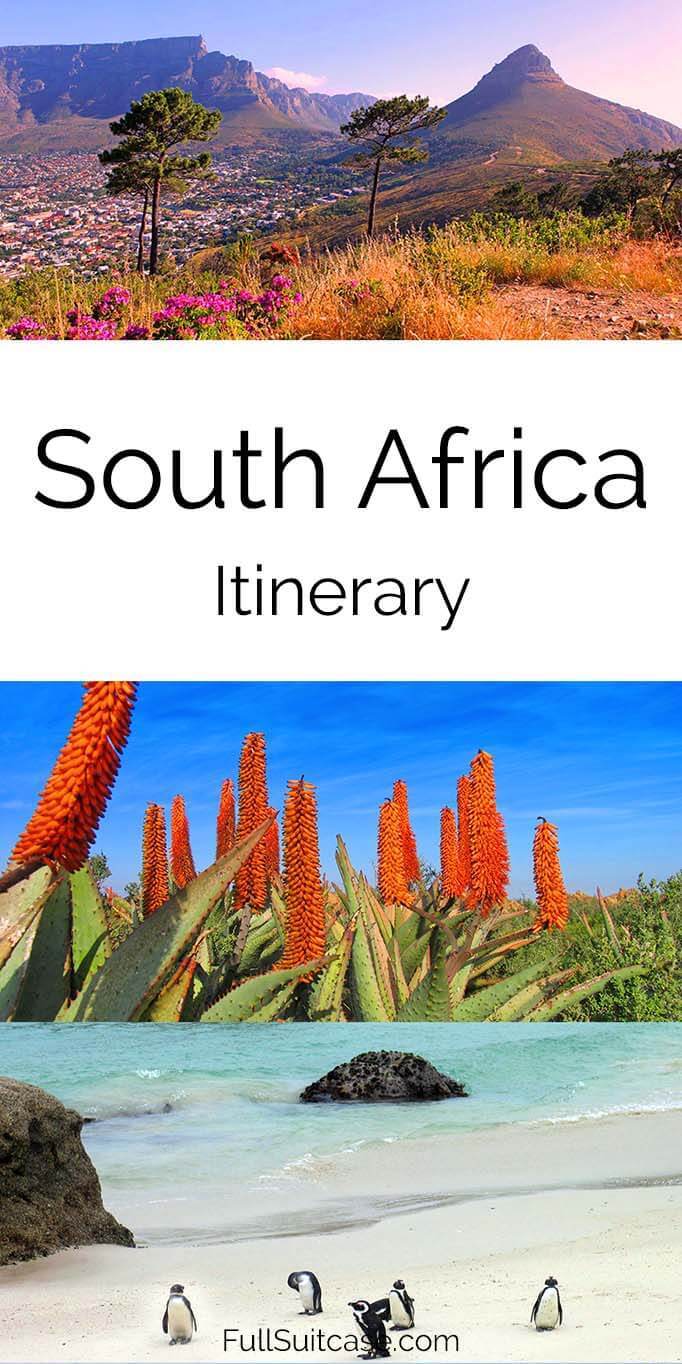
Here is our 2-week South Africa itinerary:
Day 1: Arrival in Johannesburg and drive to Kruger NP
We arrived in Johannesburg early in the morning where we picked up our rental car. At first, we were planning to visit the city of Pretoria, but after some consideration, we decided to head straight to our accommodation next to Kruger National Park.
On the way to Kruger, we stopped at Ndebele cultural village in Botshabelo. It’s just a small village-museum where you can visit a few colorful houses and get acquainted with the small Ndbele tribe community. It’s definitely worth a short stop and is a great way to break a long drive.
In the evening we had dinner at our hotel in Hazyview and met our first African wildlife. The hotel is not called ‘Hippo Hollow’ for nothing… Unforgettable experience!
- Driving distance: 424 km – 263 miles – 5 hrs.
- Accommodation: We stayed 2 nights at the Hippo Hollow Country Estate in Hazyview, just outside Kruger NP. Hazyview is a good base for exploring Panorama Route and Kruger NP and there is a wide range of accommodations available.
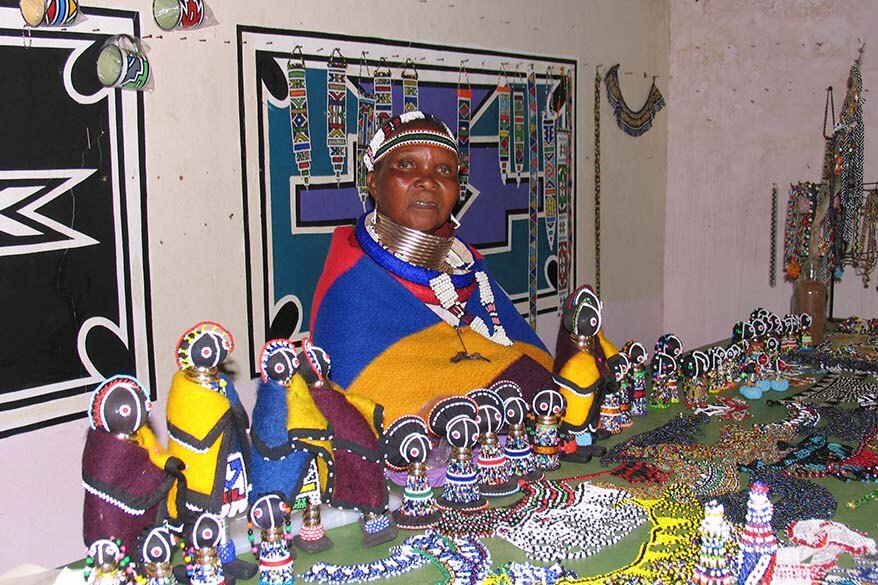
Day 2: Panorama Route
If you come to Kruger, don’t miss the Panorama Route. It’s a beautiful area that you can easily explore by car on your own. The main highlights include The Pinnacle, God’s Window, Bourke’s Luck Potholes, and Blyde River Canyon with World’s End and the Three Rondavels.
Make sure to stop for pancakes at Harrie’s Pancake Bar in Graskop. The nearby Pilgrim’s Rest is a nice small town, a former gold mining village that you could check out as well. Alternatively, you can visit Shangana Cultural Village near Hazyview.
TIP: If you rather not drive yourself, you can book a guided day tour that brings you to all the nicest places in this area.
- Driving distance: 185 km – 115 miles – 3 hrs + stops (count the whole day).
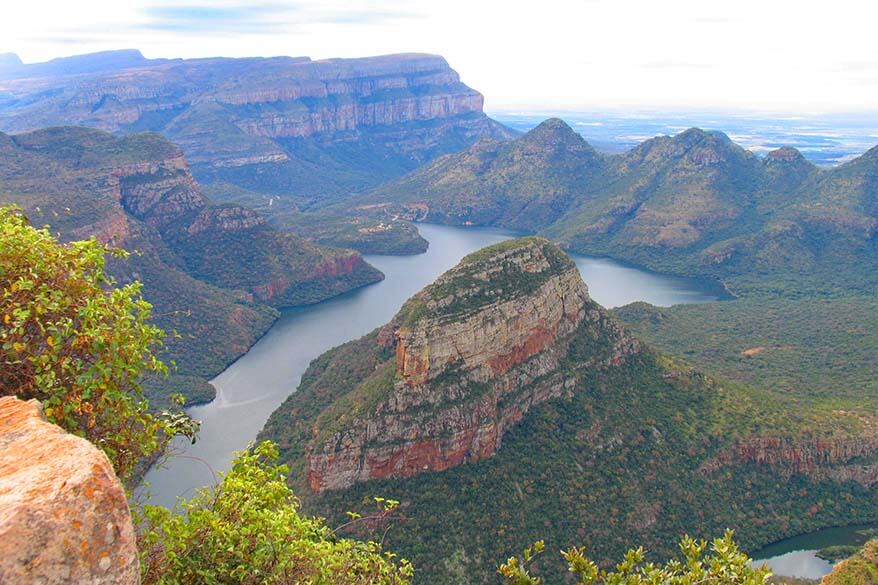
Day 3: Kruger National Park
In order to enjoy a real safari experience in Kruger National Park, we left our car at the hotel and booked a 4×4 guided half-day safari tour of Kruger NP.
It was nice not to have to drive and just enjoy the wildlife and nature around us. The local guide brought us to places that are inaccessible to private vehicles. On top of that, the guides communicate with each other so they know where the animals are.
Despite booking a group tour, we had the whole jeep to ourselves and it was a great first safari experience. We saw four out of the Big 5 of Africa (lion, leopard, rhino, elephant; later on we also saw the Cape buffalo), and lots of other animals including giraffes, baboons, antelopes, crocodiles, hippos, impalas, kudus, wildebeests, hyenas, zebras, etc.
TIP: It is freezing cold on a safari drive early in the morning, so dress accordingly. We visited in July (winter in South Africa), so we wore warm jackets and we also used the blankets provided by the tour guide. By noon, it was warm enough to just wear a shirt. But even if you visit in summer, the warmth comes and goes together with the sun, so you still need warm clothes for morning safari rides.
LEARN MORE: Safari Tips
We returned to Hazyview for lunch. After that, we picked up our car and drove to Kruger NP ourselves. Kruger is quite easy to explore individually, but you have to stay on the main roads and make sure to not leave your car at any time.
We ran into a whole family of lions with cubs, saw an elephant just next to the road, and many other wild animals.
- Driving distance: morning safari +- 100km – 60 miles – 2-5 hours depending on the stops to watch wildlife.
- Accommodation: 1 night at River House Lodge. You can stay pretty much anywhere in the southern part of Kruger, close to Malelane or Marloth Park. It would fit very well with this itinerary.
- TIP: If you have more time in the area consider staying at least 2-3 nights in Kruger National Park. There are many lodges inside the park, from basic camps to high-end luxury accommodations. Here you can find the best deals for accommodation in different areas in the south of Kruger NP: Hectorspruit, Skukuza, Sabi Sand Game Reserve, and Marloth Park.
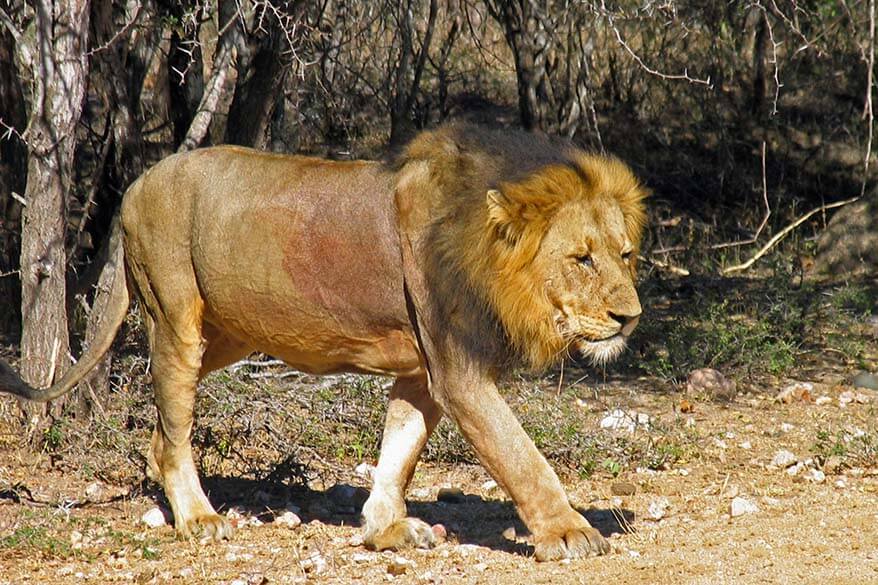
Day 4: Kruger NP – Eswatini (previously Swaziland) – Saint Lucia
We left early in the morning hoping to see some wildlife before leaving Kruger for a long drive towards St Lucia. And we were very lucky again – we saw a group of leopards hunting for breakfast and a herd of elephants pulling out and eating entire bushes…
We then drove in the direction of the border with Eswatini (formerly known as Swaziland) – the shortest route towards Saint Lucia. The passport control/immigration at the Swaziland border took us a bit longer than expected and after seeing all kinds of warning signs (for cholera, AIDS, and signs like ‘do not open windows or door’) we decided to just drive through without stopping anywhere. The country is beautiful, but also very poor, and many places reminded us of things we saw in India’s poorer regions.
After a long drive through this smallest country in the Southern Hemisphere, we re-entered South Africa again on our way to Saint Lucia.
- Driving distance: 440 km – 275 miles – 6 hours.
- Accommodation: We stayed 2 nights in St Lucia.
Good to know: If you rather not cross any borders, you can drive from Kruger National Park to St Lucia via South African roads. This will add about 1.5-2 hours of driving time.
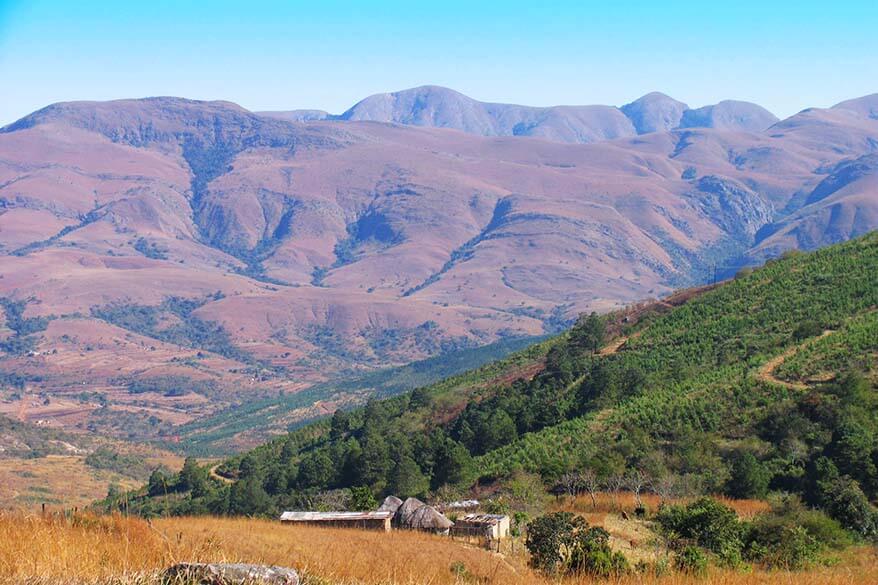
Day 5: St. Lucia and Hluhluwe–Imfolozi Park
In the morning we again took a guided safari drive to the nearby Hluhluwe–Imfolozi Park. It’s not as busy as Kruger and we saw fewer animals here, but it was a nice experience with some unforgettable animal encounters.
At one moment we stood eye-to-eye with a huge elephant bull who wanted us to know that we were in his territory. Our big 4WD looked minuscule next to this animal so our driver quietly obeyed and drove back… and back… until the elephant put his foot back on the ground signaling that he wasn’t going to turn our car into a matchbox…
You can also visit this park in your own car, but sometimes it’s really nice not to have to drive and just look for the animals.
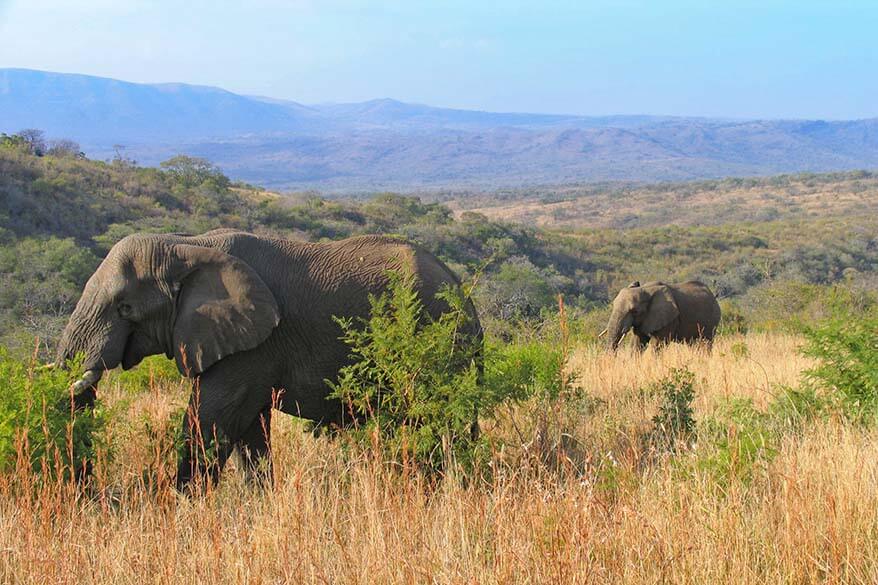
We spent the afternoon at the pool of our hotel.
In the late afternoon, we took a boat trip on St. Lucia Lake where we saw hundreds of hippos and crocodiles. We decided not to go for a swim here ;).
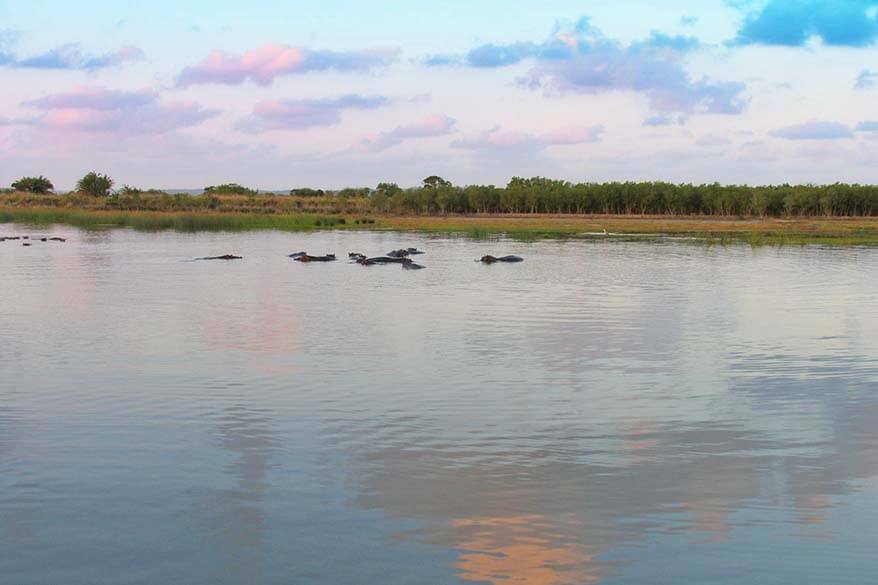
Day 6: St. Lucia – Durban
We left Saint Lucia and drove to Durban where we explored the city. The waterfront area of Durban reminded us of Australia’s Surfer’s Paradise: big waves and hundreds of surfers on the beach. Other things to do in Durban include Golden Mile, Indian area, Victoria Street Market, UShaka Marine World...
- Driving distance: 245 km – 150 miles – 3 hours.
- Accommodation: We stayed at the Blue Waters Hotel in Durban for 1 night. Since we are not big fans of cities, we felt that we could have easily skipped Durban altogether and gone straight to the Drakensberg Mountains. On the other hand, the distance would be a bit big meaning you’d spend the whole day in the car. Alternatively, you can also stay at a nearby Umhlanga, a nice holiday town just outside of Durban.
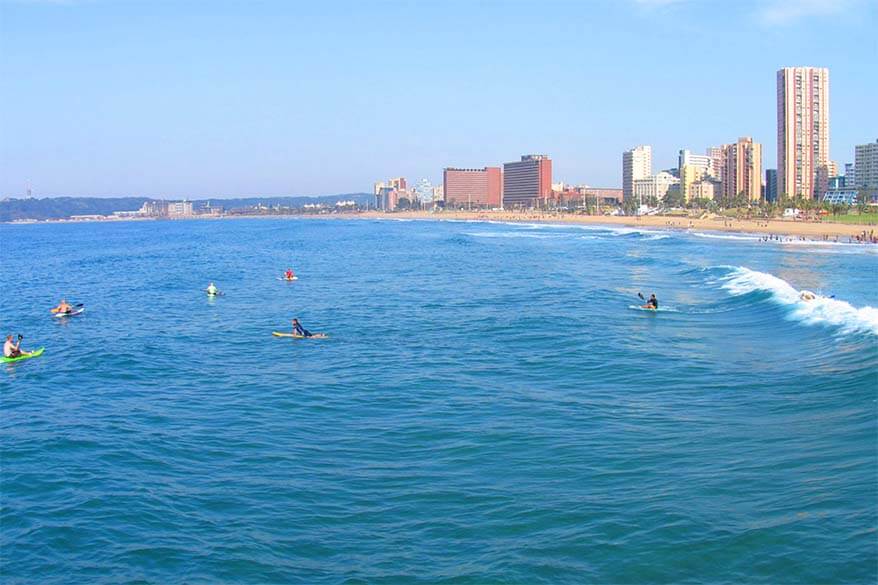
Day 7: Durban – Drakensberg Mountains
Our first stop was Pietermaritzburg, known as the place where Gandhi was thrown of the train because he dared to travel first class as a non-white person. A visit to the city of Pietermaritzburg is an interesting experience. It was the first time we were in a South African city which was not that touristy.
The drive to Drakensbergen is worth a trip in itself – so beautiful. On the road, we also stopped at Howick waterfall.
In the afternoon we made a short sunset walk in the mountains, just next to our hotel. Apart from the fantastic scenery we also encountered a group of baboons.
- Driving distance: 250 km – 155 miles – 3 hours
- Accommodation: We stayed 2 nights in Gooderson Drakensberg Gardens Golf and Spa Resort. Here you can find more accommodation options in Underberg.
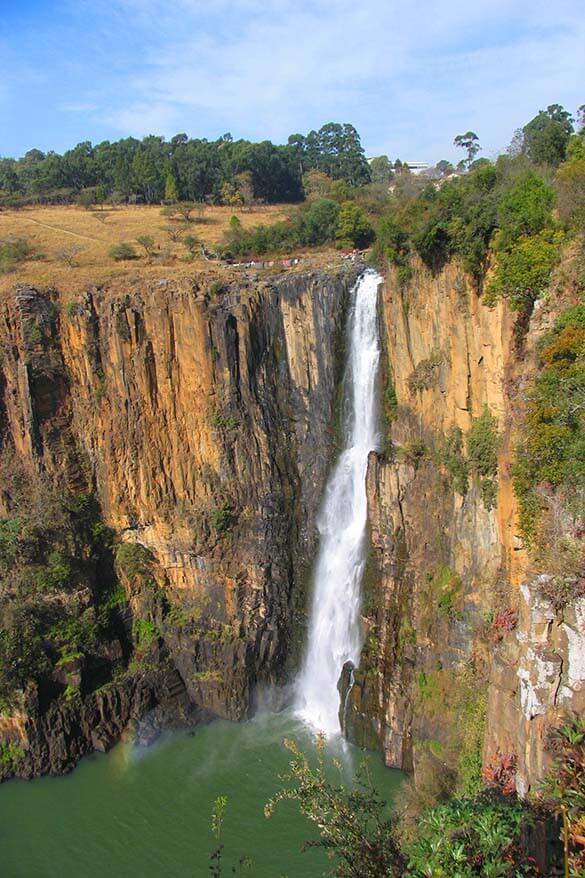
Day 8: Drakensberg Mountains
This was the most relaxing day of the whole trip. We spent the whole day in the proximity of our hotel. We went for a nice walk in the mountains, went horse riding, played some mini-golf, etc.
Alternatively, you could make a day trip to the nearby Kingdom of Lesotho.
TIP: If you decide to visit Lesotho, you may want to do it with a local guide who knows the region well and has a 4×4 vehicle. Here you can book a Lesotho day tour from Underberg.
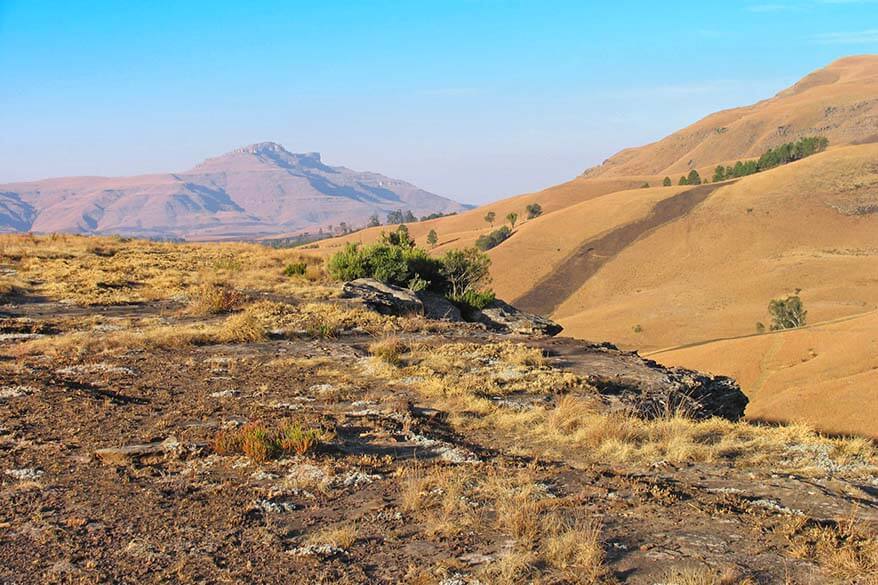
Day 9: Drakensberg Mountains to Durban. Flight to Port Elizabeth and Garden Route to Knysna
After a relaxing day yesterday, this day was filled with traveling. We left our hotel in the Drakensberg mountains early in the morning (5 AM) in order to catch a flight to Port Elizabeth.
Undredal is not next door to Durban, so it’s quite a far drive of 235 km which takes about 3 hours. If you prefer not to have to drive that far before taking a flight, you may want to stay in Durban one more night.
It was freezing cold this early in the morning: -7°C (19F). Whereas the previous day in Durban it was 23°C (73F). That’s typically Africa – the sun goes down and it gets really cold, no matter the season.
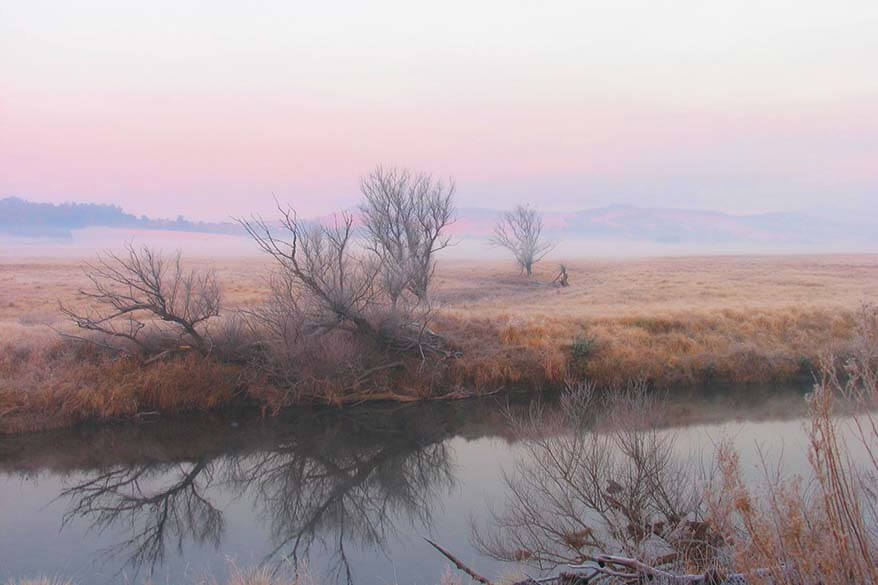
We flew to Port Elizabeth where we picked up another rental car and drove part of the Garden Route to Knysna. We didn’t have much time for sightseeing because we had to reach Knysna before the dark which is around 5.30P M in July. So we only made a short stop at the Storms Point along the way.
- Driving distance: 270 km – 170 miles – 3,5 hours to Durban plus 270 km – 170 miles – 3 hours to Knysna.
- Accommodation: We stayed in Knysna Hollow Country Estate for 3 nights. Knysna is our favorite place along the Garden Route and on our next trip to South Africa, we spent a week there (even contemplating if we shouldn’t move to live here). There is so much to see and do in the area and the town itself is really nice too. If you want to add some days to your South African itinerary, consider staying here longer.
TIP: You could skip Drakensberg Mountains if you are short on time or add a day to your itinerary if you don’t want to fly. In that case, count two days to drive from Durban to Port Elizabeth. Sleep in the East London area along the way.
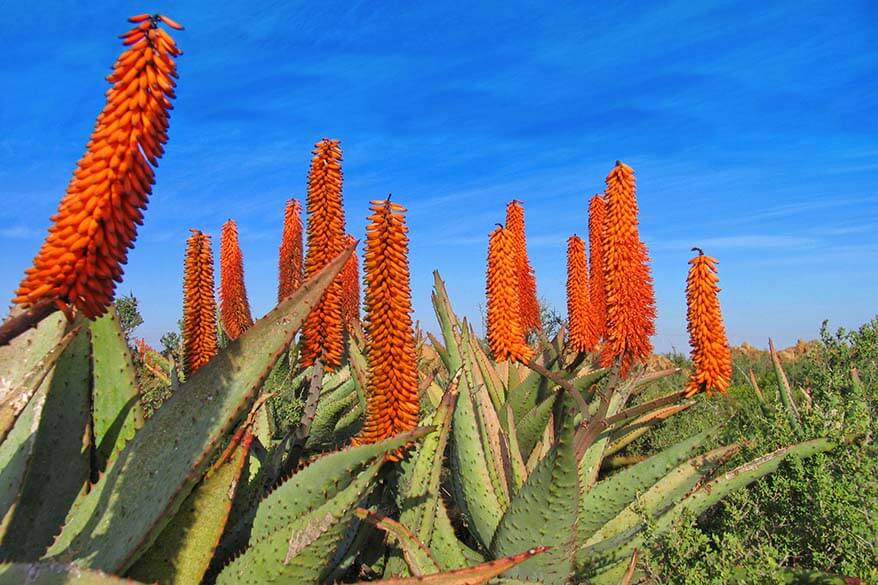
Day 10: Garden Route
As already mentioned, there is a lot to see and do in and near Knysna. On our first day on the Garden Route, we decided to stay close to town.
In the morning we took a boat to the Featherbed Nature Reserve (must do!). In the afternoon we visited Knysna Elephant Park where we could feed the elephants (also a must in Knysna). In the evening we had dinner at one of the many restaurants at Knysna Waterfront.
TIP: One of the nicest things to do in Knysna is to take a boat tour along the beautiful coast. Here you can find a nice selection of boat tours in Knysna.
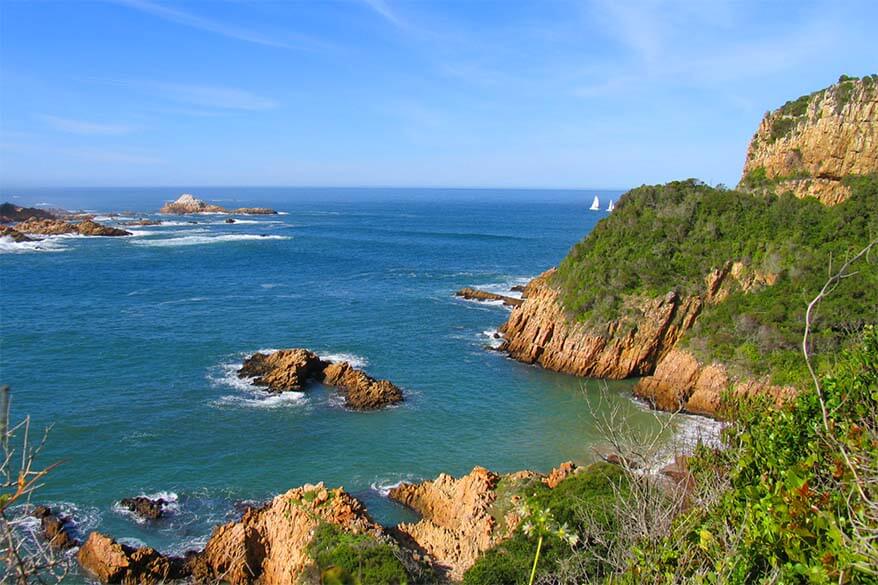
Day 11: Garden Route
There are many ways to spend an extra day on the Garden Route.
On this first trip in South Africa, we visited an ostrich farm in Oudtshoorn (there are many farms there, some more touristy than others), followed by a visit to Cango Caves.
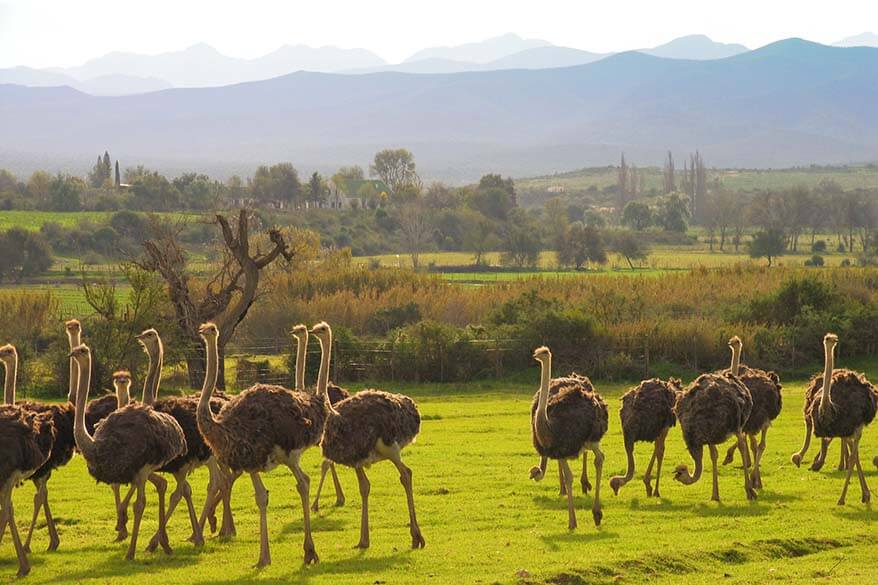
Alternative things to do along the Garden Route would be visiting Tsitsikamma National Park (beautiful place), Robberg Nature Reserve (spectacular hiking along the coast), or places like Monkeyland (walk among the monkeys in a forest – great for families!) and Birds of Eden (also great for families), etc.
You can go to the beach, make a safari ride in a private game reserve, watch whales and dolphins, or find a really nice restaurant serving the famous Knysna oysters and South African wine… Whatever your interests, you’ll love the diversity of the Garden Route!
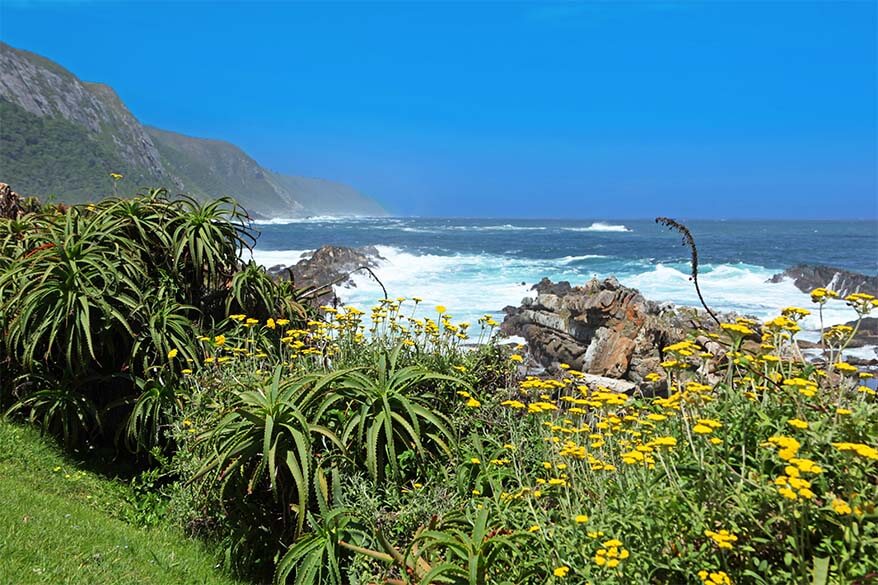
Day 12: Knysna to Cape Town via Cape Agulhas and Hermanus
A very long but beautiful drive from Knysna to Cape Town with a few stops today.
We chose to visit Cape Agulhas, the place where the Indian Ocean meets the Atlantic Ocean. It’s a big detour and a long drive to get here. It felt a bit like being at the end of the world, but we loved it!
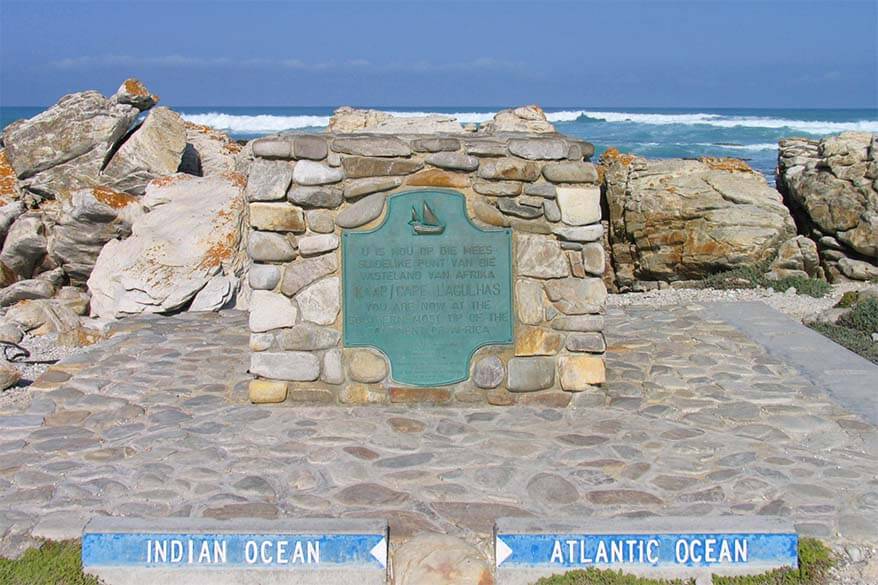
Our next stop was Hermanus – the best place for whale watching in South Africa. You can go on the boat and see whales and dolphins up close (we did it on another occasion), but usually you can see some of them from ashore as well.
If you can fit it in your itinerary, make sure to do a whale-watching boat trip. Just book in advance, definitely in high season July through November.
- Driving distance: 500 km – 310 miles – 6 hours to Hermanus. Add another 120 km – 75 miles – 1,5 hrs to Cape Town.
- Accommodation: We spent 3 nights in Cape Town and stayed at Cape Town Lodge Hotel.
TIP: If I were to do this South Africa trip again, I would opt to spend a night in Hermanus rather than rushing to Cape Town. It’s a long day as it is and Hermanus definitely deserves more time than just a short stop.
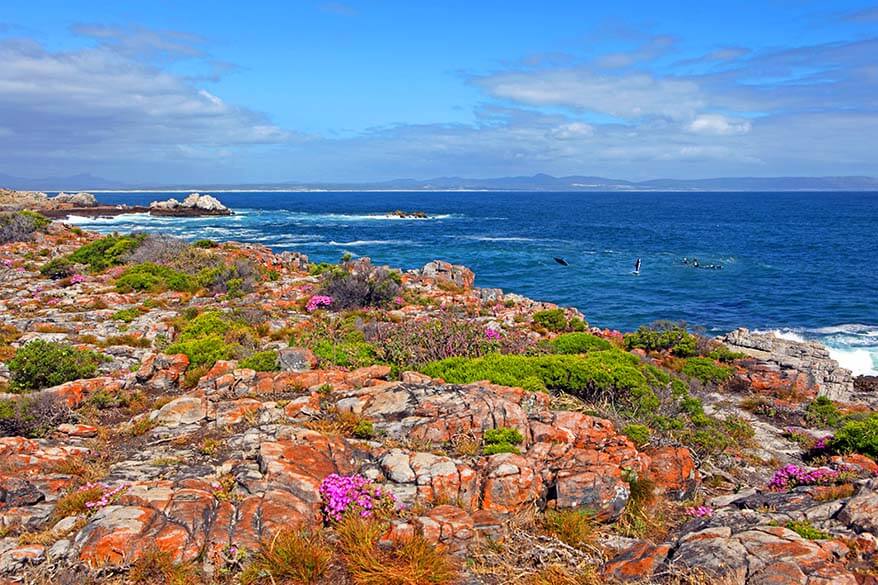
Day 13: Cape Peninsula
Cape Peninsula deserves more than a few days! But if you have just one day to explore the area near Cape Town.
As a minimum, try to visit the Boulders Beach penguin colony in Simon’s Town, the Cape of Good Hope Nature Reserve, drive the scenic Chapman’s Peak Road, and take a boat to the seal colony near Hout Bay. This is a lot for one day, but it’s feasible.
TIP: If you are staying in the city center and want to return your rental car earlier, you can also visit these places with a guided Cape Point tour from Cape Town.
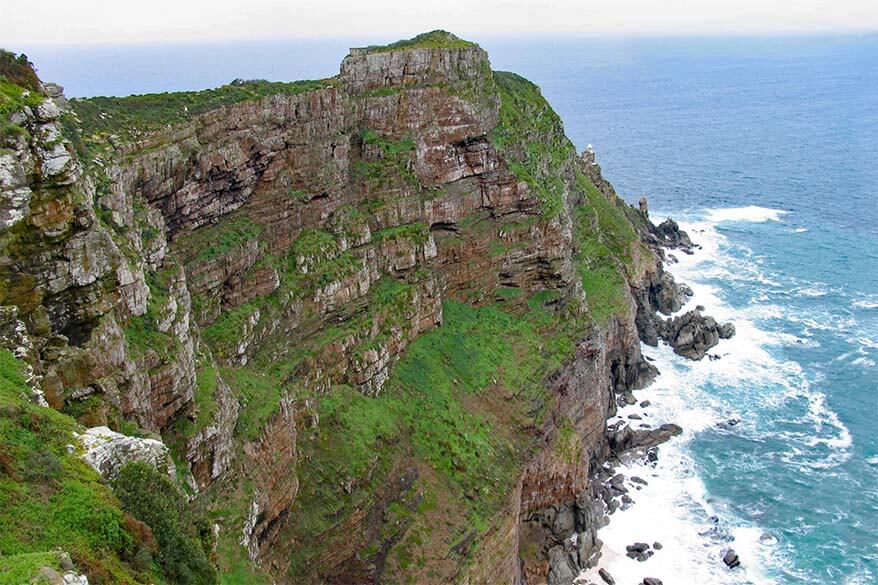
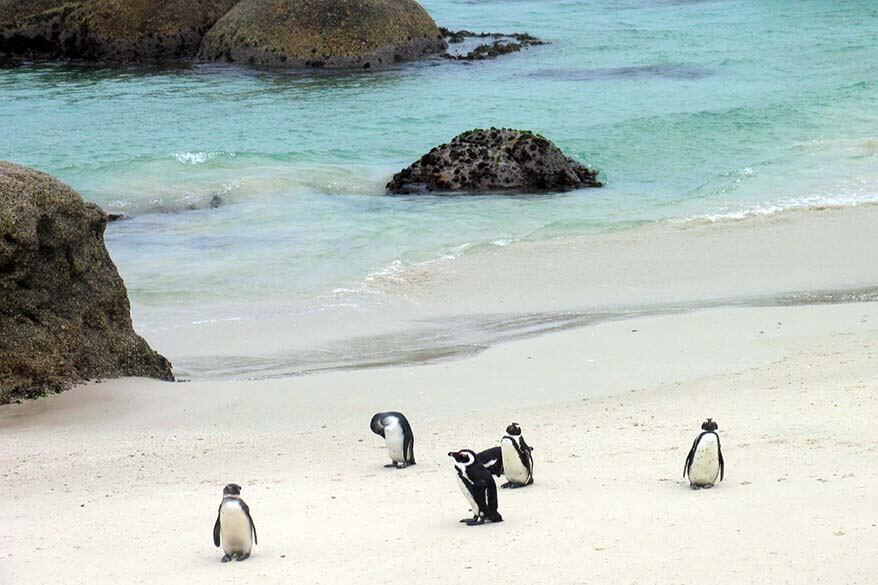
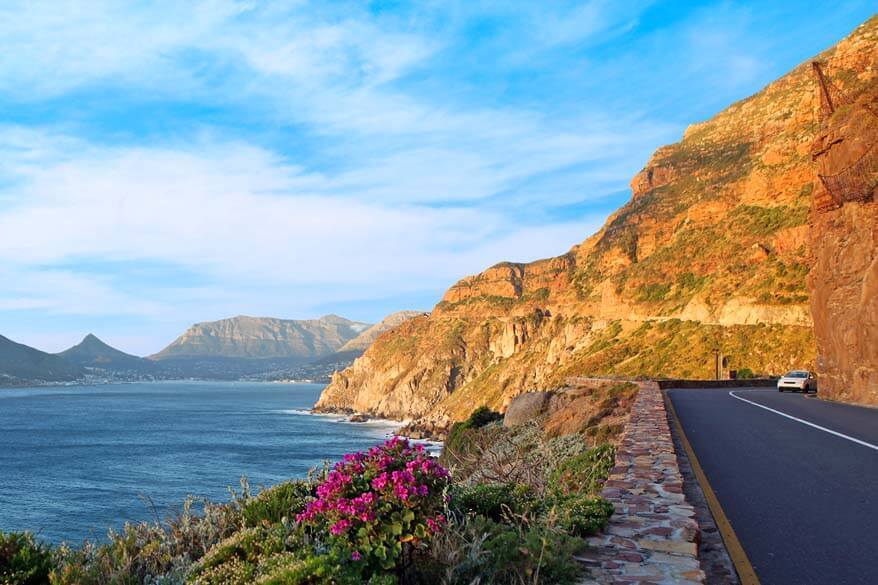
Day 14: Cape Town
One day in Cape Town is really short. Here are the highlights that you should try to visit even if you only have a day: Table Mountain, Signal Hill, Victoria & Alfred Waterfront area, colorful houses of Bo-Kaap, and also the city center.
If you have time, take a boat to nearby Robben Island. It’s the place where Nelson Mandela was imprisoned for many years.
TIP: Consider leaving your car and taking a hop-on hop-off bus to explore the city. It’s one of the most convenient and cheapest ways to travel around Cape Town. Car parking is not easy to find in town and the distances are quite big.
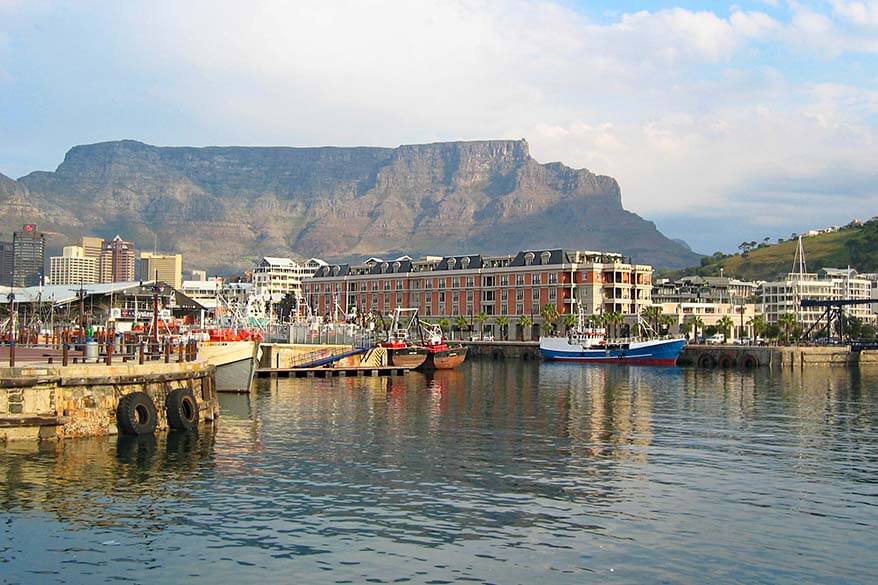
Day 15: Cape Town and departure
Depending on your departure time you could visit some of the places that you didn’t manage to see the previous days. There is so much to see and do in Cape Town!
We loved the Kirstenbosch Botanical Gardens just outside the city. A visit to the Stellenbosh wine region is also a popular (half-)day trip from Cape Town.
Here you can also find the most popular and best-rated day trips from Cape Town: Cape Winelands and wine tasting tours that visit Franschhoek, Paarl, and Stellenbosch areas.
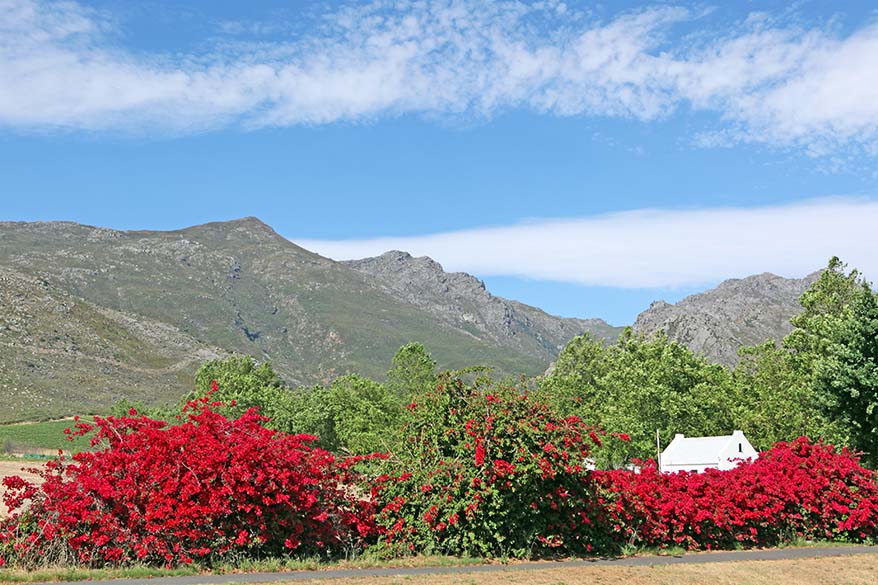
Practical information for a self-drive road trip in South Africa
- You can easily rent a car and explore South Africa individually. Here you can find some of the best deals for car rental. Be sure to take full insurance!
- You don’t need a 4WD for South Africa as the main roads are all paved and generally in very good condition.
- At the time of writing, you can drive in South Africa with any driver’s license that is printed in English. Otherwise, you should obtain an International Driver’s License before your trip.
- You can make this trip in any season. We traveled in July when it was winter in South Africa.
- Consider that the distances are big and if you are really short on time it’s probably better to fly from the north of the country to the south.
- Is it safe to travel in South Africa on your own? While not the safest country in the world, South Africa can easily be explored on your own. Just use your common sense, read the signs, avoid township areas, and don’t drive at night.
- Don’t drive around in the dark unless you absolutely have to. In some areas, you may encounter wild animals or dogs crossing the roads, and there are also often people walking next to the road, so driving after dark isn’t a great idea.
If you have any questions that I forgot to cover, please leave a comment below and I’ll do my best to help.
So, this was our itinerary visiting the best places in South Africa in two weeks. There are many ways to spend your vacation in this beautiful country, but this gives you a good idea of what can be done in a relatively short time.
Note that this trip is quite rushed, so you will not see everything. One thing is for sure – it will definitely leave you wanting to return. But then you get acquainted with so many different regions of South Africa in a short time and when you go back you can choose to explore certain areas deeper.
As for us, we went back to South Africa after this trip and spent two weeks just in the South part of the country (Garden Route and Cape Peninsula). You can find this family-friendly South Africa trip description in our article South Africa with kids and here you can find some of our favorite photos from South Africa. We cannot wait to return again!
READ ALSO: Best Places to Visit in South Africa
If you found this post helpful, don’t forget to bookmark it and share it with your friends. Are you on Pinterest? Pin this image!


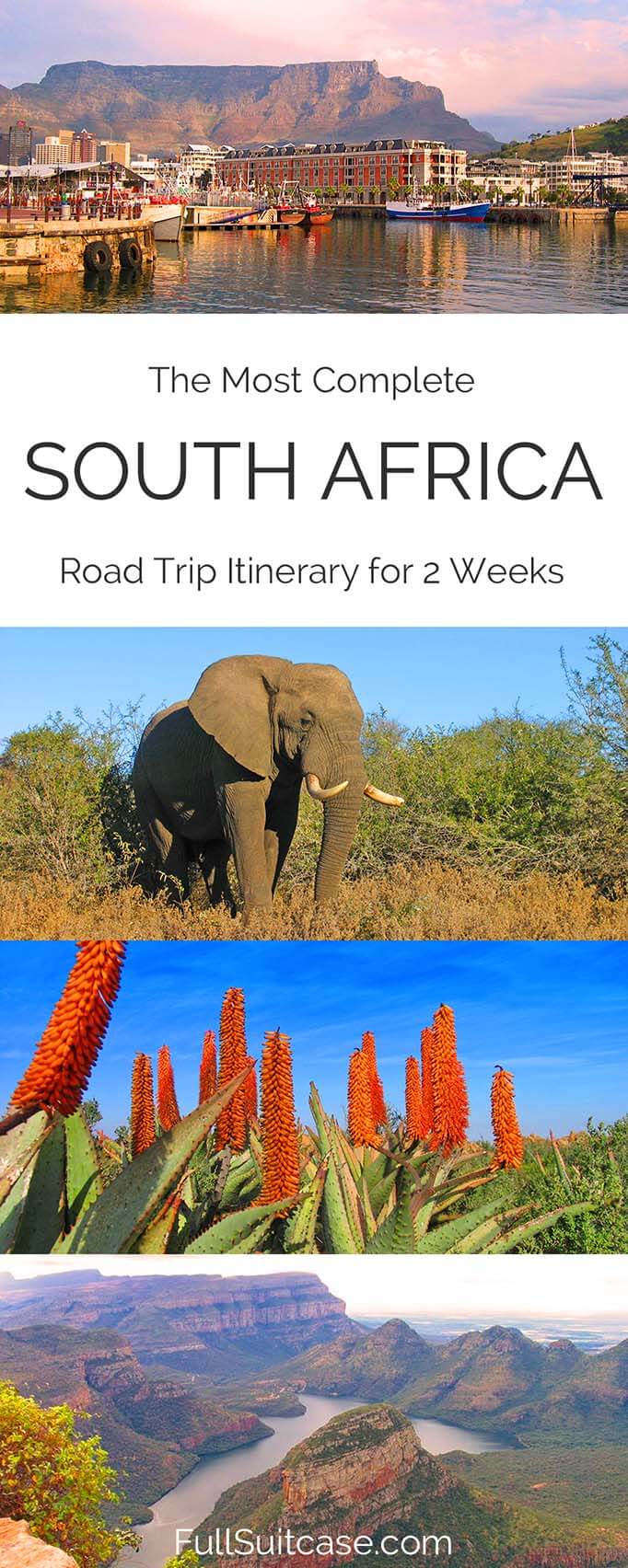
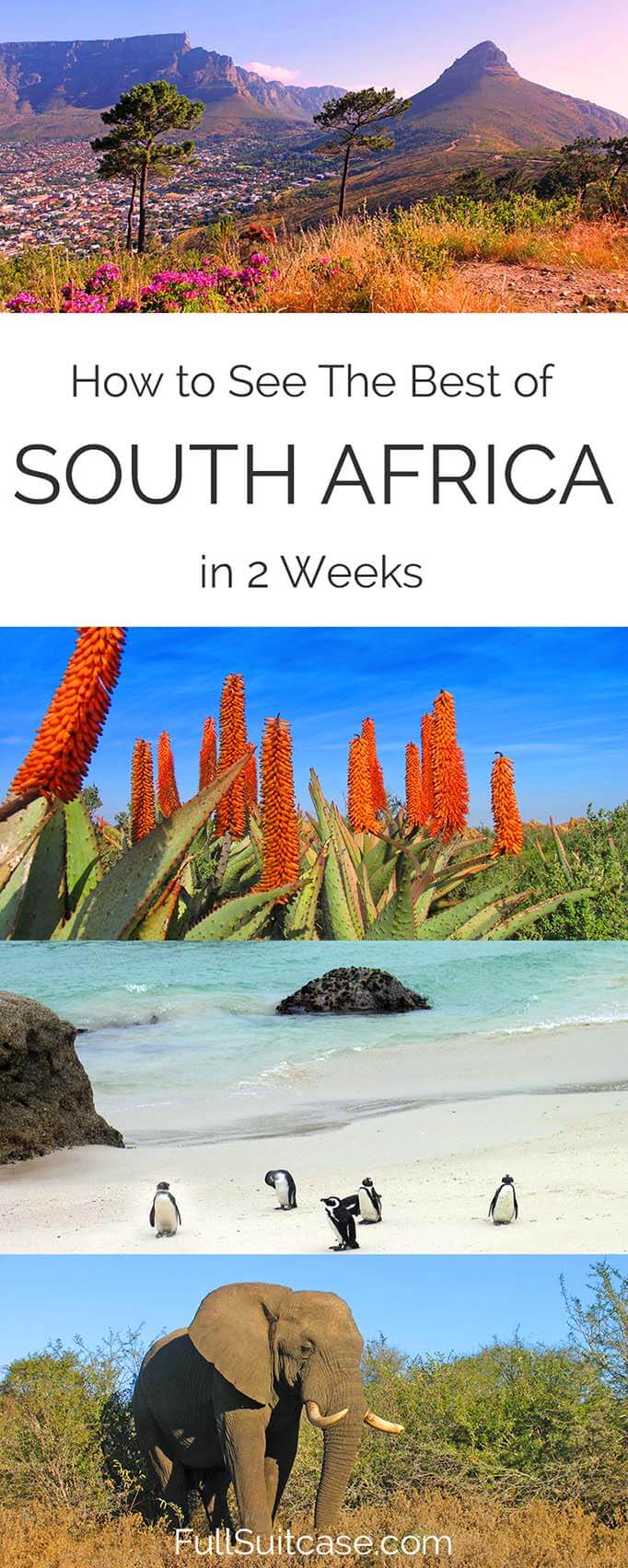

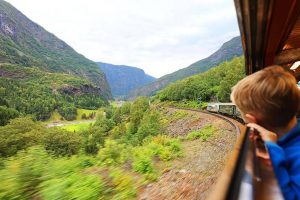
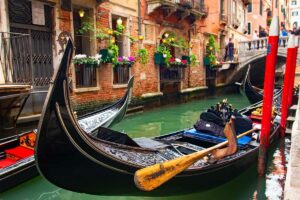
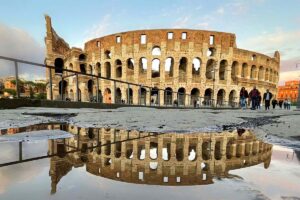
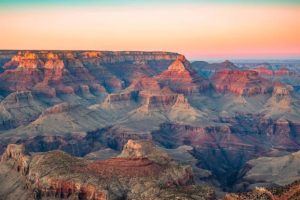
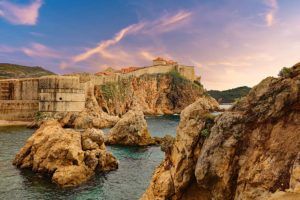
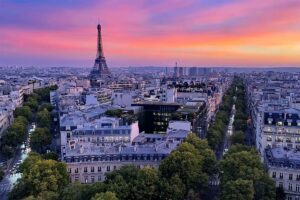
hi Jurga.
my name is Alberto, I’m from Italy. I’m planning to visit South africa in 2026 with my family: my wife and our 2 daughters. i feel we are going to have a similar experience in terms of duration and points of interest. may i ask you to provide some more details in terms of budget? how much did you spend for the whole package? the more details you can share the better is. thank you in advance
Hi Alberto, unfortunately, it’s impossible to give even a rough budget estimate for any trip, and I never do that. There are simply way too many factors that influence the price: from the exact time when you visit and when you book (overall, the earlier, the cheaper, as you have more options) to accommodation choices and even room types, etc. Just a few examples – you can fly to SA from Europe for 500-600 euros via via or you can pay two-three times more to fly directly, especially during peak times; you can find nice simple accommodations at 100-200 euros per night, or you can stay in a luxury safari camp at 1000-10000 euros per night.
The best way to get an idea of a realistic budget for your family is to check actual prices for flights, car rental, accommodations you like, and a few main activities that you absolutely don’t want to miss. My experience with any trip is that you can make it as expensive or as cheap as you choose.
Hi Jurga, Did you pre book all your accomodation or just turn up and book on the day ? Seems a very complex job to book all 2 week’s accomodation. Also wouldn’t give any scope for changing itinery en route ??
Hi Guy, we travel with kids during school holidays, so yes, we always pre-book everything. To us, it seems much more complex to do it last-minute where you have to spend time looking at what’s available for the night rather than simply enjoy your day knowing that you’ll have a place to sleep no matter when you actually get there. It also allows you to plan some extra activities for the ‘free’ days in between.
If you are completely flexible and travel in the low season, I guess you could just go with the flow, definitely in the places where there are plenty of accommodation options. However, for the more remote areas, I’d recommend booking in advance.
PS We book all our accommodations via Booking.com and try to take flexible booking/cancelation options, which usually means that we can still change plans if absolutely need be. But in the end, we rarely change anything because it’s so much easier to follow a planned itinerary when you are short on time and want to make the most of your trip. Of course, everyone travels differently and I totally see how in some situations it would be nice to keep all the options open…
Good luck!
@Jurga, Thanks for the reply – makes a lot of sense.
As a South African, I just have to say this is brilliant. than you SO much for sharing all this information!
Thanks for your feedback, Judy. Happy travels!
Hi there, awesome article! We loved reading every bit of it. We plan to visit around June 13th 2022 and plan to have about 2 weeks as well. We’re thinking of following a similar route to yours but wanted to know more about weather conditions for you. I’ve read other places that you want to stay away from the Garden route and western cape in the winter months because of rain, risk of flooding and overall not great weather. WAs that you experience?
Hello. We did this particular trip in the first half of July, so about the same time when you’re planning to travel. While it may not be ideal for Cape Town/ Garden Route, it’s a great time for watching animals in Kruger National Park. And you really never know how the weather will be anyway.
In Kruger, we had great weather. Cold nights and warm days. Usually needed a sweater or a long-sleeve shirt during the day. The same in all the other areas in the North, apart from Durban where we had t-shirt weather. It was freezing in the mountains (Drakensberg) at night, but the days were nice.
In Knysna/ Garden Route we had nice sunny weather and temperatures of about 15-18°C if I recall well. We usually wore a light sweater there. In Cape Town, we had lots of wind and some rain too, and really needed warm jackets and sweaters. I even bought a warm fleece hat. The only thing we couldn’t do at that time was going to the top of Table Mountain because the gondola was closed due to high winds, but for the rest, the weather really wasn’t an issue.
If you want to be 100% sure that you get good weather, then this is not the best time for the south coast. We once traveled there in November and that was a great time with lots of sunshine and warmth (but lots of wind too). I, personally, would do this exact same trip at any time of the year without hesitation. You can never foresee how the weather is, so pack clothes for any weather (layers are best) and make the best of what you get!
Hope this helps.
Hi! I went to South Africa (the southern part only) in 2015, I loved it! I’m thinking to return around easter of 2022 (for better temperatures than July). Have you visited Johannesburg, Pretoria or Soweto? I wonder if they are as dangerous as some people say. In my first trip in South Africa I was not scared once. We did not leave or hotel in Cape Town after dark tho. Thanks!
Hi Benedikt, we’ve only shortly passed the area from Johannesburg airport on the way to Kruger National Park. We chose not to visit the cities (nothing specific to S-A, we are just more nature people), so I have no personal experience.
One thing that we noticed around Johannesburg were warnings not to stop on the highway for any reason and not to take any hitchhikers, but this was years ago. I have no idea how the situation is there now. We didn’t really feel unsafe, but just seeing those signs gave us an impression that it was probably not the safest area… Cape Town feels very different indeed and there we have been out and about after the dark too and never felt unsafe.
I’m sure that it will be a very different experience visiting Johannesburg or Pretoria than more rural areas of South Africa or Cape Town, but I think it’s definitely worth it if you enjoy visiting cities, learning more about history, etc. Just use common sense, stay in the tourist areas, ask locals for safety advice, etc. – just as you’d do in most other big cities in the world.
Hi, we planning on following most of your itenery but skipping the garden route as we have seen that many times before. What type of did you rent… Was it a sedan or an suv/4×4. Is it not necessary to get a 4×4 if we plan on doing guided tours where you mentioned in the blog? Thanks and appreciate your blog
Hi Zahir, sorry for the late reply – crazy busy.
We never rented a 4×4 in South Africa. Since we travel with kids and have quite a few bags, we usually take an SUV. You also sit higher and see more. So it’s not that much for the roads, but for more space and comfort.
A regular car is perfectly ok for this itinerary as well.
Hey , I read the entire article and loved it completely. Can you let me know which out of so many places you mentioned are definitely must visit in South Africa. I want to slightly cut short my trip for just 10 days. Also can you share approx idea of total cost you incurred. South Africa usually comes under expensive tours.
Hi Priyanka, there are basically two possibilities for how I’d spend 10 days in South Africa (for the very first trip):
1. Fly to Johannesburg and drive to Kruger NP. Visit Panorama Route one day and then spend 1 or 2 days for Kruger NP. Drive back to Johannesburg and fly to Port Elizabeth. Drive the Garden Route, stopping in Tsitsikamma, Knysna, potentially Oudtshoorn, Port Agulhas, Hermanus. Finally, visit Cape Town and Cape Peninsula. This will be a more expensive and more rushed trip, but it should be doable if you plan well and don’t mind changing hotels often.
2. Skip Kruger NP and concentrate on the south. Fly to Port Elizabeth and visit Addo Elephant NP, then drive the Garden Route and visit Cape Town and Cape Peninsula as described above. This is a malaria-free route too and it should be cheaper as it will save you at least one flight and extra car rental. It can also be done in another direction – Cape Town to Port Elizabeth. You can also drive both ways, but that’s probably more expensive than flying between the two places, not to mention the time you save.
As for the total cost, it’s really impossible to say. Every trip is different and the price depends on when and with how many people you travel with, which hotels you choose, what kind of a car you rent… The biggest cost is the flight, followed by car rental. Hotels and food are very reasonably priced and so are the activities. We were in S-A several times, with the whole family, and every time it was one of the cheapest trips we have done, despite the very expensive flights from Europe.
Hope this helps.
Hey, I’m not sure where you heard the story about not being able to drive rental cars at night due to wild animals…. Total nonsense. We only have wild animals in the wild. It’s a foreign misconception that animals roam the streets, not true at all. It’s as developed as any major first world city
Hi Sherwyn, every time we rented a car in South Africa, we were told that we shouldn’t drive in the dark outside of the cities. It was even in our rental agreement on the first trip on which this itinerary is based. I’m not sure about the other trips – can’t remember or have those agreements anymore. It wouldn’t surprise me that those rules have changed indeed.
And I really don’t think that our article is creating a misconception that South Africa is undeveloped. It certainly is not!
Still, while there are not many places where you have wild animals on the roads anymore, a few times when we drove around in the dark (in various areas in the south and also in the north of the country), we came across many people walking next to/on the road. Maybe this habit is also going away (I sure hope so), but based on our experience, I’d still not recommend driving in the dark outside of the cities in South Africa unless it’s absolutely necessary.
Yes, sorry for asking you in such an unprecedented time. Sitting at home for days is making me think of vacation.
No worries. We all need to dream about better days. I’d go back to South Africa at any time.
Yes, Thank you very much Jurga. South Africa is truly fantastic. If you are looking for any other fun trips in Africa or Asia (I am Indian), I can give some places that are safe for kids and safe in general.
Thank you, Abhi. For now, we’re not planning any far trips, but we’ll be off exploring the world as soon as it’s safe to travel again. Stay safe!
Hi! I have some questions about the Garden Route in South Africa. I have heard many conflicting trips where people told me that winter is the best time to visit the Eastern part of the country, while the Cape Town and the west are great for the summer. Since you went to S.A in the winter, did you get rained out in Cape Town or on the Garden Route. We would really like to go on one big trip and don’t like risking a visit in the low season. What are you’re thoughts. Is it okay to visit Cape Town and Garden Route in the winter.
Thanks.
Hi Abhi, it’s really hard to say because you never know what you get. We were in South Africa a few times and one of those trips was indeed in their winter (July). We had beautiful weather on the Garden Route with lots of sunshine and temperatures that were warm enough to walk around with a light sweater during the day. The nights are very cold which gives amazing sunsets. When we drove to Cape Town, we had some really cold weather there. Some rain too, but mostly lots of cold wind. I still remember that we were wearing our warm winter jackets and fleece caps at the Cape Peninsula.
That being said, we didn’t feel like we missed much and we really loved that trip. That’s our experience. I know someone who visited Cape Town in July last year and they were wearing shorts and t-shirts in all their pictures and had stunning sunny weather… So you really never know.
If you have a choice, then winter (June, July, August) is probably not the best time for Cape Town. But the reality is that you never know what you get till you are there. We have little choice since we are traveling during school holidays and we are actually considering a trip to that part of South Africa in July-August next year. It’s amazing no matter the season and the weather rarely stays bad longer than a few hours or a day.
Hope this helps.
Hey, You have to come back again :), you saw a lot but at the same time missed sooooo much. I live just outside Durban now, my son lives in Johannesburg and my daughter lives in Cape Town so we always on the road, as we drive to visit them. Flying is just such a mission when there are so many interesting stops along the way. Africa is not a place it is an experience. If ever you need a bit of local info feel free to ask.
Thanks, Trisha. We have been back to South Africa after this trip and we keep on looking for affordable flights in order to go back. It’s an amazing country!
P.S. Feel free to share some of your favorite places here. I’m sure our readers will find it useful (and maybe we’ll find some new ideas as well ;)).
Thanks for sharing your itinerary! I am looking forward to heading over to South Africa and admittedly I get lazy when it comes to planning a proper itinerary. Coming across yours has inspired me and if you don’t mind I’ll be basing my trip over yours. It definitely seems you had a great time during your trip and I hope I experience the same too! And seeing your photos is just adding to my excitement. Hope to read more of your travels soon! Happy travels!
Thank you for your kind feedback, Ana. I know how intimidating it is to plan a good trip itinerary; that’s the reason why I share ours – it gives you a good idea of what you can see and do, and then it’s up to you to adjust it to your interests and travel style.
South Africa is absolutely amazing. Enjoy the trip!
How did you manage to drive so much on several days? I’m already exhausted after 200 km, let it alone be 500 km.
I guess we all travel differently. Usually, we don’t do more than 2-3 hrs driving in one go, but when you are making a long road trip like this one and want to see a lot in a short time, it’s sometimes inevitable. The longest driving days in this itinerary are from Johannesburg to Kruger NP, Kruger to St. Lucia, and then Knysna to Cape Town. For the rest, it’s not too bad.
Hi Jurga your itinerary has helped me immensely in designing mine too. I visited SA in ‘ 94, so I vividly remember a few of the exotic places but the garden drive seems incredible! Thank You so much for your inputs, m planning to travel in May with my children n grand daughter aged 5 years. I hope May is a good time to visit SA Jurga?
Hi Smita, yes, I think May is a great time to visit South Africa. I think any time of the year is 🙂
Just one thing – make sure to check if you or your family need any vaccinations or maybe malaria pills if you are visiting Kruger NP as I think May is still malaria season there. I don’t remember by heart and have no time to check now.
Enjoy your trip!
This is wonderful! thank you for this awesome itinerary. I will be going next year and already starting plans with the help of a friend in S.A. who live in Vereeniging, I don’t think I spelt that right. My initial thought is to somehow include Zimbabwe, Botswana and Namibia. But im sure it has to be fine tuned down the line.
Hi Sally, everything is possible I suppose but depends on how much time you have. We’ve been to S-A several times and still didn’t see the big part of it. We spent 4 weeks in Namibia and could go back to explore more…
Even if you just visit the main highlights of each of these countries, I think you’d need at least a month.
Sounds like an amazing adventure. Enjoy the planning and the trip!
The Garden route segment of the trip seems like a lot of driving. We were wondering if the sites are worth it, from your experience, or if those few days are better spent at Cape Town/Cape Penninsula and Kruger area?
Hi, it depends on how much time you have. I find that Garden Route is one of the most beautiful regions in South Africa, but just driving it you won’t see much – you need some time to explore. So if you have at least 3-4 days extra, I’d say go for it. Otherwise, just stay in Cape Town and Cape Peninsula, maybe drive to Hermanus – all amazing places that you shouldn’t miss!
As a South African I’d like to say that it isn’t actually forbidden to drive a rental car at night. There is no such rule. There are wild animals in SOME areas, not the majority of places. You are more likely to encounter cows, sheep and goats than actual wild animals.
Also, driving at night isn’t an issue in itself if you stay out of dangerous areas (ask the locals) and avoid driving in the early hours of the morning.
Hi Viki, I know there is no rule that forbids you to drive a car at night and of course many locals do that. Yet every time we rented a car in South Africa we were explicitly told it was forbidden to drive in the dark. Not sure if this has changed or if it depends on the car rental agency or your insurance contract, so as a minimum I’d advise our readers to check their car rental agreements very well. In any case, I think it’s a good idea for tourists not familiar with the place not to drive around most rural areas after dark. It’s not just about animals, but also people walking next to the dark roads, and general safety.
But thanks for sharing your local’s perspective, which I’m sure will be very helpful to our readers as well!
Thank you for sharing your experience. I am planning a trip in Mid November and getting some insights on how much these tours cost you, as well as car rental, could help me come up with the overall budget. If you do have this information handy, would you mind sharing it?
Hi Frank, South Africa is in general not very expensive. The most expensive for us was the flight from Europe.
Car rental depends on the vehicle you choose, the pick-up and drop-off locations, number of days, etc. The same with hotels. You can find lodges for a thousand dollar a night or you can find a really nice room for 50. So you can make this trip as expensive or as cheap as you like. Please check Booking.com for hotels – you can use their very handy map function to find accommodations in the locations that suit you. The price will also depend on the number of people in the room, etc.
We didn’t do many tours that you have to pay extra for, just whale watching in Hermanus and I think one safari ride in Kruger (the rest we did by car). Also a couple of other places where you have to pay an entrance fee, but it’s not that expensive at all.
It’s hard for me to give you a budget as every trip is so different and everyone travels different ways and has different expectations from their trip.
I think you should count a minimum of 1500-2000 EUR for a two week trip per person if you are traveling with at least 2 people, but I’m sure some people will manage to do it much cheaper, and some others will spend multiple times as much.
Thank you Jurga for your reply. I was initially planning this with a friend but he has pulled out and now I am thinking of doing this with my family (son 12yrs and daughter 9yrs old). Now I really need to plan this well. Thank you again.
We just got back from a 3 week trip to South Africa and fell in love too! We did more or less the same as you guys did in 2 weeks. The wildlife encounters were definitely the highlight for me, although Kruger National Park was a bit disappointing compared to the game drives at Grietjie Private Nature Reserve (part of Greater Kruger). Guess it has a lot to do with luck too. 🙂
Apart from the wildlife we were impressed with the nature in South Africa as well, and absolutely loved the food. We had a lot of steak and yum, I had some great mashed potatoes there as well! Oh, and Malva Pudding? Need to try and make it myself!
It’s funny how often the little details are what makes the trip special. Thanks for sharing your experience in South Africa, Birthe. I think Kruger can be a hit or a miss indeed. We were there in July which is dry season and therefore much better for wildlife viewing than now in winter when everything is green and animals have plenty of water, so don’t come out of the bush too often. Also, there is much more wildlife to be seen in e.g. Namibia or Eastern Africa (Tanzania or Kenya) than it is in South Africa. But to me wildlife is just a very small part of the incredible variety of things that you can do and places that you can see, it’s a mix that you don’t find anywhere else. Mountains, beaches, scenic roads, stunning coastlines, cultural diversity, elephants, lions, but also penguins and whales, monkeys, ostriches… Not to mention the food and the wine indeed. South Africa has it all… It’s what makes it so special and unique.
We are planning to visit South Africa with my family (2 adults and 2 kids -7 and 11 years old) on December for 12-13 days. I also read your itinerary that made with kids. I t will be our first time visiting SA, which itinerary do you recommend for us?
Hi Yasemin, if you are planning a trip this Christmas – New Year holidays, you may want to check accommodations before deciding on a specific itinerary. At this point, it might be difficult to find (affordable) accommodations in some of the most popular tourist areas such as Kruger NP and similar.
That said, the two trips described on our blog are very different. This one is a real road trip with lots of driving, different hotels, etc. Whereas the family itinerary just focuses on Cape Town and the Garden Route and you could even do the whole trip just by staying in 2-3 different hotels if you want to. So it’s much more relaxing and a lot easier to plan.
Unless you absolutely want to visit Kruger, I think I’d opt for the south of the country. There is so much to see and do, there are nice beaches, and no malaria mosquitos.
Just whatever you decide to do, book your accommodations asap, especially if you are traveling during the school holidays!